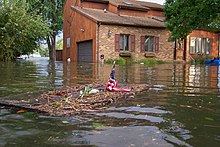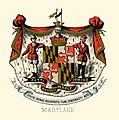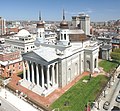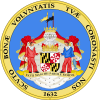|
Maryland Portal
|
Baltimore Task Force
|
Frederick Task Force
|
Montgomery Task Force
|
WikiProject Maryland
|
|
Main page
|
Discussion
|
Introduction Maryland (US: /ˈmɛrɪlənd/ MERR-il-ənd) is a state in the Mid-Atlantic region of the United States. The state borders Virginia to its south, West Virginia to its west, Pennsylvania to its north, Delaware to its east, the Atlantic Ocean, and the national capital of Washington, D.C. With a total area of 12,407 square miles (32,130 km2), Maryland is the ninth-smallest state by land area, and its population of 6,177,224 ranks it the 18th-most populous state and the fifth-most densely populated. Maryland's capital is Annapolis, and the most populous city is Baltimore. Occasional nicknames include Old Line State, the Free State, and the Chesapeake Bay State. It is named after Henrietta Maria, the French-born queen of England, Scotland, and Ireland during the 17th century. Maryland's coastline was first explored by Europeans in the 16th century. Prior to that, it was inhabited by several Native American tribes, mostly the Algonquian peoples and, to a lesser degree, Iroquoians and Siouans. As one of the original Thirteen Colonies, Maryland was founded by George Calvert, 1st Baron Baltimore, a Catholic convert who sought to provide a religious haven for Catholics persecuted in England. In 1632, Charles I of England granted Lord Baltimore a colonial charter, naming the colony after his wife, Henrietta Maria. Unlike the Pilgrims and Puritans, Lord Baltimore envisioned a colony where people of different religious sects would coexist under the principle of toleration. In 1649, the Maryland General Assembly passed an Act Concerning Religion, which enshrined this principle by penalizing anyone who "reproached" a fellow Marylander based on religious affiliation. Nevertheless, religious strife was common in the early years, and Catholics remained a minority, albeit in greater numbers than in any other English colony. Maryland's early settlements and population centers clustered around rivers and other waterways that empty into the Chesapeake Bay. Its economy was heavily plantation-based and centered mostly on the cultivation of tobacco. Demand for cheap labor from Maryland colonists led to the importation of numerous indentured servants and enslaved Africans. In 1760, Maryland's current boundaries took form following the settlement of a long-running border dispute with Pennsylvania. Maryland was an active participant in the events leading up to the American Revolution, and by 1776, its delegates signed the Declaration of Independence. Many of its citizens subsequently played key political and military roles in the war. Although then a slave state, Maryland remained in the Union during the American Civil War, its strategic location giving it a significant role in the conflict. After the Civil War, Maryland took part in the Industrial Revolution, driven by its seaports, railroad networks, and mass immigration from Europe. Since the 1940s, the state's population has grown rapidly, to approximately six million residents, and it is among the most densely populated U.S. states. , Maryland had the highest median household income of any state, owing in large part to its proximity to Washington, D.C., and a highly diversified economy spanning manufacturing, retail services, public administration, real estate, higher education, information technology, defense contracting, health care, and biotechnology. Maryland is one of the most multicultural states in the country; it is one of the six states where non-Whites compose a majority of the population, with the fifth-highest percentage of African Americans, and high numbers of residents born in Africa, Asia, Central America, and the Caribbean. The state's central role in U.S. history is reflected by its hosting of some of the highest numbers of historic landmarks per capita. (Full article...) This is a Featured article, which represents some of the best content on English Wikipedia..
In Maryland and Washington, D.C., the effects of Hurricane Isabel were among the most damaging from a tropical cyclone in the respective metropolitan area. Hurricane Isabel formed from a tropical wave on September 6, 2003, in the tropical Atlantic Ocean. It moved northwestward, and within an environment of light wind shear and warm waters, it steadily strengthened to reach peak winds of 165 miles per hour (266 km/h) on September 11. After fluctuating in intensity for four days, Isabel gradually weakened and made landfall on the Outer Banks of North Carolina with winds of 105 miles per hour (169 km/h) on September 18. It quickly weakened over land and became extratropical over western Pennsylvania the next day. On September 19, Tropical Storm Isabel passed through extreme western Maryland, though its large circulation produced tropical storm force winds throughout the state. About 1.24 million people lost power throughout the state. The worst of its effects came from its storm surge, which inundated areas along the coast and resulted in severe beach erosion. On the Eastern Shore, hundreds of buildings were damaged or destroyed, primarily in Queen Anne's County from tidal flooding. Thousands of houses were affected in Central Maryland, with severe storm surge flooding reported in Baltimore and Annapolis. Washington, D.C., sustained moderate damage, primarily from the winds. Throughout Maryland and Washington, damage totaled about $820 million (equivalent to $1.36 billion in 2023), with only one fatality due to flooding. (Full article...)General imagesIn the news
On this day...The Maryland portal currently doesn't have any anniversaries listed for May 26. You can help by viewing the page source of an existing entry at /On this day to see how the entries should be formatted, then adding the missing entry. This is a Good article, an article that meets a core set of high editorial standards.
The 1973 Preakness Stakes was the 98th running of the Preakness Stakes at Pimlico Race Course in Baltimore, Maryland held on May 19, 1973. Six horses entered, and Secretariat won by 2+1⁄2 lengths ahead of Sham in front of a record crowd of 61,657 spectators. The race was viewed on television and broadcast over the radio. In the period leading up to the Preakness, Kentucky Derby winner Secretariat was pegged as the favorite to win the race. Aside from Secretariat, Sham was named as the only other horse that could win the race or even challenge Secretariat. Initially seven horses officially enrolled to race in the event, but the field reduced to six after an owner scratched his horse. The entrants in the Preakness featured three horses that did not compete in the Derby. At the start, Secretariat broke last, but then made a huge, last-to-first move on the first turn. After reaching the lead with 5+1⁄2 furlongs to go, he was never challenged, and won by 2+1⁄2 lengths, Sham finishing second and Our Native third. The victory led to the stallion being featured on several magazine covers. Secretariat would go on to win the Belmont Stakes in the succeeding weeks, becoming the ninth horse to complete the Triple Crown of Thoroughbred Racing and the first in 25 years. (Full article...)Selected article - The Baltimore and Ohio Railroad (reporting mark BO) was the first common carrier railroad and the oldest railroad in the United States. It operated as B&O from 1830 until 1987, when it was merged into the Chessie System; its lines are today controlled by CSX Transportation. The railroad was founded to serve merchants from Baltimore who wanted to do business with settlers crossing the Appalachian Mountains. It would compete with several existing and proposed turnpikes and canals, including the Erie and Chesapeake and Ohio Canal. Building west from the port of Baltimore, the B&O reached Sandy Hook, Maryland, in 1834; Cumberland in 1842; the Ohio River at Moundsville, Virginia, in 1852; Wheeling, Virginia, in 1853; and in 1857, Parkersburg, Virginia, below rapids that made navigation difficult during parts of the year. (Full article...)Did you know?

SubcategoriesSelect [+] to view subcategories
TopicsRelated portalsAssociated WikimediaThe following Wikimedia Foundation sister projects provide more on this subject:
Discover Wikipedia using portals
Purge server cache
|

























































Recent Comments